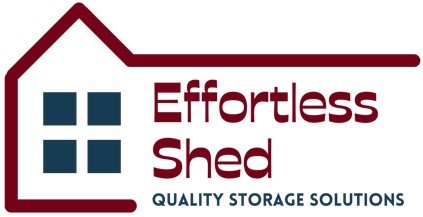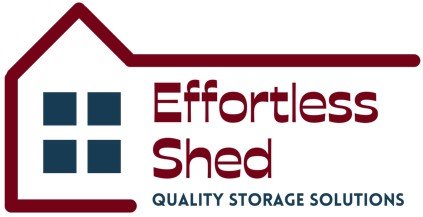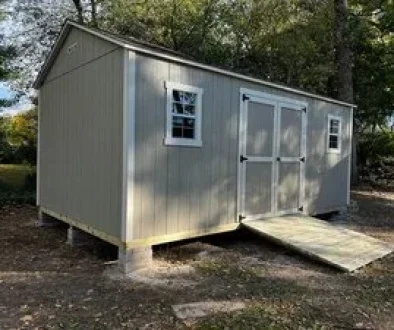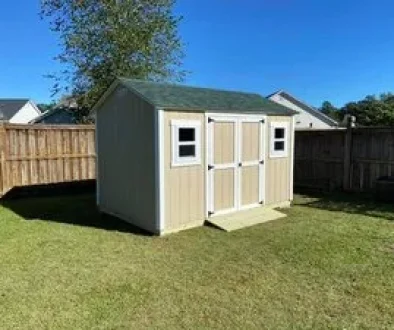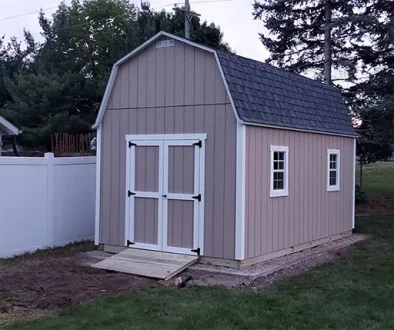How Much Does a 12×24 Shed Cost?
If you plan to add a 10×12 shed to your backyard, the first thing to check is if you need a permit. This shed size equals 120 square feet, which is right at the limit many areas allow without paperwork. Some towns let sheds up to 120 square feet slide without approval, while others set the limit at 100 square feet, meaning a permit may be required.
In general, if your shed is only used for storage, placed on a basic foundation like gravel or skids, and has no electrical wiring, some places may not ask for a permit. But in other areas, the same shed could need approval due to its size or placement.
Since the rules change from one location to another, the safest step is to contact your local building office or planning department before starting. A quick check upfront saves you from fines, insurance problems, or being told to remove the shed later.
Why Shed Size and Height Must Be Considered?
When it comes to permits, the size of the shed is often the first thing inspectors look at. A 10×12 shed covers 120 square feet, which is considered large for a backyard structure. Many towns use this measurement as the maximum allowed without a permit, so even a small increase in size can change the rules. For example, if you were to build a 12×12 shed, you would likely cross into the range that requires approval almost everywhere.
Height is another factor that makes a difference. A shed with walls under 8 feet and a standard gable roof may not cause much concern, but if you add extra height for storage lofts or choose a barn-style roof, the structure becomes more noticeable. Taller sheds can block sunlight, change the look of the property, and even affect neighbors, which is why local authorities may ask for a permit if your shed is higher than the allowed limit.
Keeping your shed within both the size and height rules is one of the simplest ways to avoid permit problems. Always check how your city measures sheds, too, since some places include the roof overhang in their calculations, while others measure only the floor space. A shed that seems acceptable by floor size could still need a permit if its roof extends beyond the set limits.
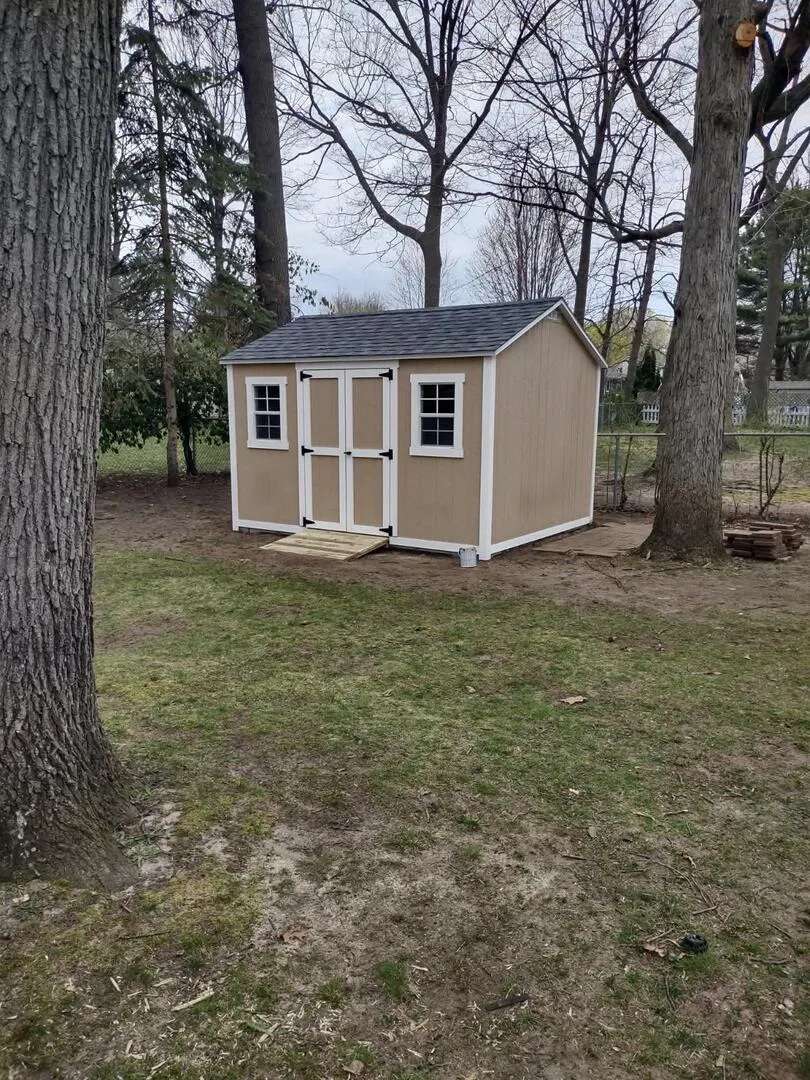
Factors That Decide If You Need a Permit or Not
A 10×12 shed does not always need a permit, but a few extra details about how it is built and used can quickly change the situation. Local authorities look at more than just square footage when deciding if paperwork is required.
1- Location on Your Property
Where you place the shed can make a difference. Many towns have setback rules that require a shed to be a certain distance from fences, property lines, or other buildings. Even if your shed is the right size, placing it too close to your neighbor’s yard might trigger the need for a permit.
2- Foundation Type
The type of base you use is also considered. A shed placed on simple gravel or skids is often viewed as temporary and may not need approval. However, a concrete slab is considered permanent, which usually means a permit will be required.
3- Use of the Shed
What you plan to do inside the shed matters as well. A shed used just for storing lawn tools or bicycles is less regulated. If you want to set it up as a workshop, home office, or even a guest room, you will most likely need permission.
4- Utilities
Adding electrical wiring, plumbing, or insulation automatically places the shed in a higher category. These upgrades affect safety and must be inspected, so a permit is almost always necessary.
5- Height and Design
Taller sheds, or those with unique roof styles, may also require approval even if the floor size is acceptable. By paying attention to these factors before you build, you can avoid delays and surprise costs later.
Local Zoning and HOA Rules
Even if your city or county allows a 10×12 shed without a permit, zoning laws and homeowners’ association rules can change things. Zoning regulations decide how land can be used in your area, and they often include limits on where and how large a shed can be. For example, a rural property may allow a shed of 120 square feet without paperwork, while a suburban neighborhood may require permits for the same size.
Setback rules are also common. These are the required distances between your shed and other property features like fences, trees, or your neighbor’s yard. If your shed is too close to a boundary line, you could run into problems even if the shed itself does not exceed the size limit.
If you live in a neighborhood with a homeowners’ association, you will need to follow their rules as well. HOAs often set stricter limits than the city. They may have rules about shed color, style, or placement to keep the neighborhood uniform. Ignoring these can lead to warnings, fines, or even being told to remove the shed.
What Happens If You Skip the Permit
Skipping the permit process may feel like a shortcut, but it can bring several problems later on. Local authorities can issue fines if they discover an unpermitted shed on your property. In some cases, you might even be ordered to take the shed down, which means all your money and effort would be wasted.
Another issue comes up when selling your home. Buyers and inspectors often check for permits on any structures in the yard. If your 10×12 shed was built without approval, it could lower your property value or even delay the sale until the problem is fixed.
Insurance is another important factor. If your shed is not permitted and gets damaged by a storm, fire, or other events, your insurance company may refuse to cover the loss. That leaves you paying out of pocket for repairs or replacement.
In short, skipping the permit may save a small fee and some paperwork in the beginning, but the risks of fines, removal, and insurance issues make it a costly choice in the long run.
Tips to Get Quick Approval for a 10×12 Shed
- Getting a permit for your 10×12 shed does not have to be stressful if you prepare ahead of time. Start by gathering all the documents your local office might ask for. These usually include a site plan that shows where the shed will sit on your property, the dimensions of the shed, and details about the foundation and roof type. Having everything ready speeds up the review process.
- It also helps to talk with your local building department before filling out the forms. A quick visit or phone call can clear up any confusion about size limits, setbacks, or special rules in your area. This prevents your application from being delayed or rejected.
- If you live in a community with an HOA, reach out to them early as well. Sometimes, HOA approval is needed before the city or county will give the final permit. Getting both permissions at the same time keeps your project moving without interruptions.
- Lastly, be patient but proactive. Many offices process permits within a few days, while others may take a couple of weeks. Checking in politely on the status of your application shows that you are serious and helps keep things on track.
Wrapping Up
A 10×12 shed is a useful addition for extra storage or workspace, but it is important to know the rules before you start building. Many areas allow small sheds without permits, but size limits, zoning laws, and HOA rules can change what applies to you. Taking a little time to check the requirements saves you from fines, legal issues, or even the risk of having to remove the shed later.
Think of the permit as a simple step that protects your investment. With the right paperwork, your shed becomes a legal part of your property, adds value to your home, and stays covered under insurance. It also gives peace of mind knowing that the structure is built safely and correctly.
So, before putting down a foundation or ordering materials, reach out to your local building office and check the rules. That small effort upfront makes your 10×12 shed a smart and lasting improvement to your property.
